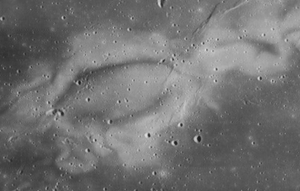Magnetic Fields Explain Lunar Surface Features
For decades, lunar scientists have been perplexed by sinuous patterns of light-colored material on the surface of the Moon. In Physical Review Letters, researchers provide new evidence for the theory that localized bubbles of magnetic fields on the lunar surface are responsible for the features. The team combines observational data, plasma theory, and a scaled-down laboratory experiment to make their case. In addition to solving a persistent lunar mystery, understanding the phenomenon on the Moon might be the first step toward developing deflector shields to protect spacecraft and astronauts from solar storms during long space journeys.
Lunar swirls are bright, wispy patterns on the lunar surface that stand out against the otherwise dark lunar soil, like hundred-kilometer-wide bleach stains, seemingly unrelated to the local topography. Over a dozen swirls have been discovered on the Moon, but lunar scientists haven’t agreed on an explanation for them. Each swirl marks the location of a magnetic anomaly, or “mini-magnetosphere”—a bubble of magnetic field lines shaped like an egg-beater rising out of the lunar surface. One theory is that these magnetic anomalies—whose origin is also a mystery—might somehow protect the areas they cover from space weathering, while the rest of the surface is darkened by the impact of the solar wind.
But in the simplest view, it should be impossible for a mini-magnetosphere to deflect all particles in the solar wind the way the Earth’s magnetic field does. The magnetic field around a lunar swirl isn’t strong enough to deflect protons, given the size of the protected region.
The key, says Ruth Bamford of Rutherford Appleton Laboratory (RAL) in England, is that an electric field is generated by the magnetic field’s interaction with the solar wind. Heavy positive ions from the solar wind crash through the magnetic field bubble, while lighter electrons are diverted around it. This separation of positive charges from negative ones generates an electric field directed outward from the magnetic anomaly. This electric field powerfully deflects most of the positive ions, but the field persists because some of them continue to penetrate a short distance and maintain the charge separation. The electric field is strongest in a thin layer that “drapes” over the anomaly like an umbrella. Over millions of years of solar wind bombardment, this shielding can create bright regions of protected surface separated by narrow dark lanes.
Previous theoretical modeling of this scenario hasn’t been completely convincing, says Erika Harnett of the University of Washington in Seattle. “Nobody has the simulations exactly perfect,” she says, and the approximations necessary to make the problem tractable might make it hard to draw direct parallels to actual observations.
Bamford and her colleagues set out to test whether a thin layer of electric field really could form and deflect a stream of energetic ions. They had previously performed an experiment to simulate the use of magnetic fields to shield spacecraft from solar storms [1], and they were able to modify the setup to make a lab-scale model of a lunar magnetic anomaly. Using the RAL’s Plasma Wind Tunnel, they simulated the solar wind with a stream of protons and electrons about a centimeter wide. The team placed a magnet the size of a pencil eraser in the beam, positioned to create a bubble of magnetic field the same shape as a lunar magnetic anomaly. As expected from the theory, a thin, dome-shaped shell of electric field formed around the magnet and deflected the streaming particles around it. The shell thickness matched predictions, and the team concluded that the same mechanism, scaled up, should work on the Moon.
Harnett says that Bamford’s paper includes a compelling argument tying in existing observation and theory, but “the experimental work is what knocks it out of the park.” Georgiana Kramer of the Lunar and Planetary Institute in Texas agrees that the lab result makes Bamford’s work unique. “They are doing actual experiments,” she says, “that, to me, is very, very important.”
Bamford and Harnett both say that a working design of a spacecraft deflector shield based on this work may not be far off and that understanding solar wind shielding on the Moon could be a big step toward making deflectors practical. “If you understand it, you can optimize it,” Bamford says. “The technology to do it is not so hard.”
–Katie Mack
Katie Mack is a cosmologist at Cambridge University and an occasional freelance science writer.
References
- R. Bamford et al., ”The Interaction of a Flowing Plasma with a Dipole Magnetic Field: Measurements and Modelling of a Diamagnetic Cavity Relevant to Spacecraft Protection,” Plasma Phys. Contr. Fusion 50, 124025 (2008)





